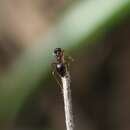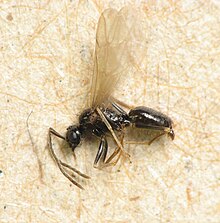en
names in breadcrumbs


Worker small to very small, monomorphic, the body, legs, and scapes usually beset with sparse, coarse, erect, blunt hairs. Head rounded subrectangular or subelliptical, with rather narrow, dentate mandibles, their apical borders oblique. Clypeus large, convex, its anterior border entire or sinuately emarginate in the middle, not or scarcely produced over the bases of the mandibles. Frontal carinae very short and straight; frontal area poorly denned. Antennary and clypeal fossae not confluent. Maxillary palpi 6-jointed; labial palpi 4-jointed. Antennae 12-jointed, inserted near the posterior angles of the clypeus; scapes elongate, funiculi filiform or slightly thickened distally. Eyes moderately large; ocelli absent. Thorax short, more or less constricted in the mesonotal region. In some species the mesonotum is elongate and subcylindrical. Promesonotal and mesoepinotal sutures distinct. Epinotum more or less convex above, unarmed. Petiole with an anteroposteriorly compressed scale, which is inclined forward. Gaster oval, convex in front, where the first segment covers the petiole, the tip pointed. Legs slender. Gizzard long and narrow, its calyx straight at the base, with the sepals reflected at their anterior tips.
Female decidedly larger than the worker. Head proportionally small; thoraxand gaster massive; pronotum short, vertical; mesonotum broad, flattened, with distinct parapsidal furrows; scutellum convex, often longitudinally impressed in the middle. Wings with a single cubital cell; discoidal cell present or lacking.
Male scarcely larger than the worker. Head resembling that of the worker and female. Mandibles usually edentate. Antennae 13-jointed; scapes rather long; funiculi filiform. Petiolar node thick. Genital valves rather small and narrow, varying conside ably in the details of their structure in different species. Wings as in the female.
The PUPAE are not enclosed in cocoons.
This genus is cosmopolitan, but most abundantly represented in the Indomalayan and Neotropical Regions. There are few species in Africa. Two, P. longicornis and vividula , have been widely distributed by commerce and, though originally tropical, often manage to live permanently in northern hothouses or even in apartment houses that are heated throughout the winter. Nearly all the members of the genus nest in the ground in small craters or under stones and usually form only moderately populous colonies. They are timid, harmless ants of little or no economic importance. Emery has divided the genus into three subgenera: Prenolepis , sensu stricto, Euprenolepis , and Nylanderia , the last containing the great majority of the species.
E1 [endemic to California], E2 [endemic to California floristic province (Hickman, 1993)]
P. imparis Say is very common in mesic habitats at low and medium elevations throughout most of the state. Nests are located deep in the ground, and workers do not forage during the hottest periods of summer. A collection of unusually small alate queens from one locality in the foothills of the Sierra Nevada appears to represent a second, undescribed species, which might be a social parasite of P. imparis (Wild 2002). References: Creighton (1950a), Fontenla (2000), Lynch et al. (1980), Smith (1965), Tschinkel (1987), Wheeler (1930c).
- La Digue, 2 [[ queen ]] apteres.
C'est peut-etre une forme nouvelle que je ne me hasarde pas a decrire sur des materiaux aussi insuffisants.
Die in meinen Europ. Form, fuer die [[ worker ]] dieser Gattung aufgestellten Charaktere erleiden durch den Hinzutritt exotischer Arten in die Gattung eine Beschraenkung und zwar: In Bezug des Clypeus ist zu streichen: „ dessen Vorderrand in der Mitte bis zur Schildgrube seicht ausgerandet, so dass die Oberkiefer nicht an die Mitte des Clypeus-Vorderrandes stossen "; ferner ist das Fehlen der Stirnrinne kein constanter Charakter, so wie die Worte: „ Netzaugen hinter der Mitte des „ Kopfes " auszulassen sind. In meinen Europ. Form, habe ich mir in der analytischen Tabelle einen grossen Fehler zu Schulden kommen lassen, indem ich angab, dass die Schildgrube in die Fuehlergrube uebergeht, eine Angabe, welche durchaus unrichtig ist.
Das [[ queen ]] von Pr. nitens Mayr ( Formica crepusculascens Rog.) ist mir durch Autopsie nicht bekannt, wesshalb ich nur von den exotischen Arten die folgenden Gattungscharaktere entnehme:
[[ queen ]] Die Kopftheile wie beim [[ worker ]], das Stirnfeld ist aber sehr undeutlich oder nicht abgegrenzt. Der Thorax steigt oben am Pronotum senkrecht in die Hoehe, kruemmt sich vorne am Mesonotum nach rueckwaerts, bildet eine wenig convexe Scheibe, welche ziemlich breit ist, setzt sich in gleicher Hoehe auf dem Schildchen fort und biegt sich allmaelig am Metanotum, maessig convex zum Ende des Thorax hinunter. Der Thorax hat eine ziemliche Breite, eine geringe Hoehe und eine mittlere Laenge. Schuppe und Hinterleib sind wie beim [[ worker ]] gestaltet. Die Fluegel haben eine Cubitalzelle und eine besonders grosse Discoidalzelle, welche aber auch durch das Fehlen der Costa recurrens nicht abgegrenzt sein kann. Die Sporne sind wie beim [[ worker ]] dornfoermig, die Krallen einfach und duenn.
Prenolepis is a genus of ants in the subfamily Formicinae.[2] Most species are found in southeastern Asia and southern China, but the genus has a wide distribution with species known from North America, southern Europe, Anatolia, Cuba, Haiti, and West Africa.[3]
 Prenolepis imparis, male
Prenolepis imparis, male Prenolepis is a genus of ants in the subfamily Formicinae. Most species are found in southeastern Asia and southern China, but the genus has a wide distribution with species known from North America, southern Europe, Anatolia, Cuba, Haiti, and West Africa.